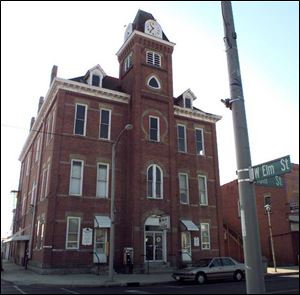
Officials scramble, cheer post-election
11/10/2005
A citizen-initiated ballot issue in Bluffton to renovate town hall passed by a 20% margin.
Budget hearings begin next week in Hancock County, and commissioners say Tuesday's defeat of a 0.25 percent sales tax hike is going to make that job a challenging one.
"We're going to look at the county's needs, look at what's mandated as far as services, and ask each official and department head to tell us where their cuts can be," said Commissioner Emily Walton. "There may be decreases in services and hours. We'll just have to see when we start these budget hearings."
Ms. Walton said the tax lost by such a wide margin - more than 4,000 votes - that it's clear the opposition to higher taxes is widespread. "The economy is such with increased fuel prices and heating, and I think all of those things played into the equation," she said.
The $2.5 million a year expected to be generated by the sales tax was to be earmarked for criminal justice services. But Ms. Walton said cuts will likely come from all areas of county government.
Maile Doyle, who was part of a citizens' group opposed to the tax, said she believes her group spoke for voters who think the county needs to prioritize spending as individuals do. The Findlay-Hancock County Chamber of Commerce also opposed the tax.
"Instead of saying give us more money to keep doing business as usual, they heard from the citizens - all of us - who have had to tighten our belts too," Ms. Doyle said.
Her group, Hancock County Concerned Citizens, hopes to see the county and city work harder to eliminate duplicated services.
Two examples she cited were the city and county health departments and the separate dispatch centers run by the police and sheriff's departments.
Voters in Henry County also exhibited an anti-tax streak, repealing a 0.5 percent sales tax that the county commissioners enacted in June.
The repeal, which takes effect April 1, will cost the county $1.1 million to $1.2 million a year.
Discussions on cutting the county budget are expected to begin at today's commission meeting.
"We've got to start talking to folks and making plans on how we arrive at a balanced budget," Commissioner Steve Baden said.
Elsewhere in northwest Ohio, tax requests from some counties and municipalities fared better at the polls.
In Sandusky County, officials learned after a night of delays caused by ballot-printing errors that a 0.25 percent sales tax to fund the countywide EMS program had passed comfortably.
Dan Liskai, president of the county commissioners, said the tax would bring in about $1.5 million a year and eventually make EMS independent of the county's general fund.
"Once and for all it's the final fix on it and it can run on its own," Mr. Liskai said. "This keeps a quality service in the county, not privatized."
The Fulton County Board of Mental Retardation and Developmental Disabilities' new levy barely passed, according to unofficial results, with 50.3 percent voting yes.
Uncounted, however, are 134 provisional ballots, cast by voters whose right to vote at that location couldn't be verified on Election Day. Those deemed valid will be opened and counted on Nov. 22.
Yesterday, disabilities board members at a special meeting were hopeful that the new 2-mill, continuing levy would maintain its slight lead.
Among the municipalities where new taxes were approved, the village of Bluffton, which straddles the Hancock-Allen County line, is moving forward with plans to renovate its 118-year-old town hall.
By a 695-586 vote, residents approved a 0.25 percent income tax expected to generate around $3.25 million over 10 years to save the downtown landmark. Village officials have talked for years about whether to renovate the three-story brick building or tear it down and build new village offices. It was a group of citizens who got an initiative on the ballot to save the building.
Village council didn't take a position on the income tax, and individual members were split on the question of restoration vs. new construction.
"I'm just kind of happy that now we have a definitive direction in which we can go," Village Administrator James Mehaffie said.
The town hall, with its stately clock tower, is well-known to passers-by and serves as an icon for the city, appearing on the local newspaper's masthead and elsewhere.
In Fostoria, which blankets the spot where Seneca, Hancock, and Wood counties intersect, voters renewed a 0.5 percent income tax that raises about $1.5 million a year.
In addition, residents overwhelmingly agreed to establish a 15-member commission that will draft a city charter proposal for submission to voters next year.
City Council President Joe Droll, a leading proponent of the charter idea, was excited by the nearly 3-to-1 margin of victory.
"In 1958, when the last charter commission was created, it squeaked by. ... I think this makes a statement, and the real winners are the people of Fostoria, because it's a good group of people who are going to be putting this thing together," Mr. Droll said.
Besides creating the charter panel, voters also elected the 15 commission members, including former city Councilman Lowell Bugner and former city Auditor Cortland Heykoop.
Blade staff writer Jane Schmucker contributed to this report.
Contact Jennifer Feehan at:
jfeehan@theblade.com
or 419-353-5972.